Panasonic Lumix DMC-TZ1 Review
Review Date: April 21st 2006
Leave a Comment about this Review
|
Ease of Use
At first glance the Panasonic Lumix DMC-TZ1 strikes you as being a little large, elongated and bulky, feeling similar in size to the Canon "A" series cameras. Then you have to remind yourself Panasonic have somehow fitted in a 10x zoom lens equivalent to 35-350mm on a 35mm camera. Other models of this size typically have a 3x or 4x zoom lens. Panasonic have used folded optics technology to achieve this zoom range. Even when set to 350mm, the lens doesn't extend far from the front of the TZ1, looking to all intents and purposes like a "normal" camera. This helps to make the DMC-TZ1 a great candid camera, as people assume that it's just a standard point and shoot model. The 10x zoom lens obviously makes this one of the most versatile compacts in terms of focal range, especially as it is coupled with Panasonic's Mega O.I.S system, which helps to ensure that the majority of photos taken in good light are sharp. If you're used to a 3x zoom lens, then the 10x zoom will be like a breath of fresh air.
It's a quite well-built camera, with a high quality plastic body and controls. The camera's design is dominated by the large 10x lens on the front and the 2.5 inch LCD screen on the rear. There is no optical viewfinder, which follows a recent trend in digital cameras, and this does make the camera a little harder to keep steady at the telephoto end of the zoom than holding it up to your eye. The chunky hand-grip, 4cm thick body and 262g partly make up for this. The DMC-TZ1 is well-made overall, although there are a couple of external controls that don't instill much confidence. The cover for the battery compartment and SD card slot feels a little insubstantial and is locked using a cheap plastic switch, whilst the plastic tripod socket is positioned in the bottom-left corner of the camera, which doesn't make it very stable on a tripod. Overall. though, the DMC-TZ1 has a "substantial" feel.
As this is purely a point and shoot camera with no manual controls, the Panasonic Lumix DMC-TZ1 is not overly complex in terms of the number of external controls that it has. I counted 12 in total. The majority of the controls are clearly labeled and common to most cameras. There's a traditional dial on the top of the camera that lets you select the various shooting and scene modes, plus image playback. This dial is a typical feature of SLR cameras, and enables you to quickly change between the various modes. Interestingly there are two Scene modes on the dial, both of which offer exactly the same options, but which can be set independently of each other, allowing a little customization of the camera setup. Also found on the top of the camera are the on/off switch, zoom lever, shutter button and the optical image stabilisation button.
| Display/LCD Mode Button / Continuous Mode/Delete Button / Navigation Pad | Tripod Mount |
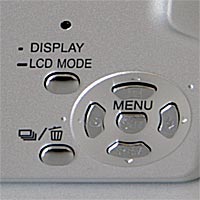 |
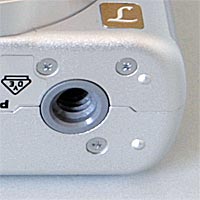 |
If you have never used a digital camera before, or you're upgrading from a more basic model, reading the easy-to-follow manual before you start is a good idea. Thankfully Panasonic have chosen to supply it in printed format, rather than as a PDF on a CD, so you can also carry it with you. The large 2.5 inch LCD screen is the only way of framing your shots, so if you have to have an optical viewfinder, look elsewhere now. There's a clever new mode called High Angle, which essentially brightens the LCD screen when the camera is held over your head so that it is perfectly viewable, which is great for shooting over the heads of a crowd. The various icons used to represent the camera settings are clear and legible, although I was annoyed by the "Press LCDMode for 1 sec" message along the bottom of the screen, which is displayed whenever you press the Display button.
The main menu system on the Panasonic Lumix DMC-TZ1 is straight-forward to use and is accessed by pressing the Menu/Set button in the middle of the navigation pad. There are two main menus, Record and Setup. Quite a lot of the camera's main options, such as white balance, image quality, auto-focus mode and ISO speed, are accessed here, so the Record menu has 10 options spread over 3 screens. It would have been good to see the more commonly used options, such as ISO speed, available via the press of a button, rather than having to go into the menu system. Due to the large LCD screen and restricting the number of on-screen choices to five, the various options and icons are clear and legible.
| Mode Dial | Zoom Lever / Shutter Button / On/Off Switch / Image Stabilisation Button |
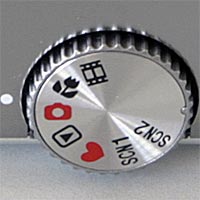 |
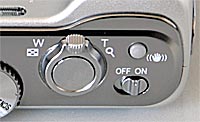 |
There is an innovative feature on the Panasonic Lumix DMC-TZ1 that aims to make life easier for you. As with current Panasonic models, this camera has an anti-shake system, dubbed Mega O.I.S - turn it on and the Panasonic Lumix DMC-TZ1 automatically compensates for camera shake, which is a slight blurring of the image that typically occurs at slow shutter speeds. There are two different modes, Mode 1 is on all the time including image composition, and Mode 2 is only on when you press the shutter button. In practice I found that it does make a noticeable difference, as shown in the examples on the Image Quality page. You don't notice that the camera is actually doing anything different when anti-shake is turned on, just that you can use slower shutter speeds than normal and still take sharp photos. However, what Panasonic gives you in the form of an effective anti-shake system, it takes away by only providing a limited effective ISO range of 80-200. This essentially means that you really need to leave the anti-shake system turned on all the time to compensate for the slow shutter speeds, especially as ISOs 400 and 800 exhibit high levels of noise (see the Image Quality page), which negates some of the advantages that the anti-shake system offers. Thankfully leaving the anti-shake system on didn't negatively affect the battery-life, with the camera managing over 250 shots using the supplied rechargeable Li-ion battery.
Panasonic have attempted to alleviate the limited ISO range problem by providing a new High Sensitivity Mode. When this scene mode is selected, the camera automatically raises the ISO speed up to a maximum of 1600 and therefore allows for a faster shutter speed. This mode allows you to handhold the camera without using the flash and get more natural results, whilst at the same time freezing subject movement more successfully. There are some obvious drawbacks with this special scene mode, principally a significant reduction in resolution - Panasonic state that "The picture quality is good enough for printing at the ordinary 4" x 6" (10 x 15 cm) size". You also need to select the scene mode and therefore have some idea about when it is applicable to your subject. You can see sample images using the High Sensitivity Mode on the the Image Quality page.
| Battery Compartment | Memory Card Slot |
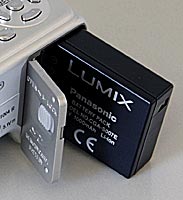 |
 |
The start-up time from turning the Panasonic Lumix DMC-TZ1 on to being ready to take a photo is quick at around 1.5 seconds. Zooming from the widest focal length to the longest is very slow at around 5 seconds, but remember that this is a 10x zoom lens. Focusing is quick in good light and the camera achieves focus most of the time indoors or in low-light situations, helped by the focus-assist lamp. Note that the camera does struggle to lock onto the subject at the tele-photo end of the lens in low-light situations. The camera is very quick to find focus if you use the new 1-point high-speed AF option. The visibility and refresh rate of the 2.5 inch LCD screen are perfectly acceptable. It takes about 1 second to store an image, allowing you to keep shooting as they are being recorded onto the memory card - there is no LCD blackout between each image. The Panasonic Lumix DMC-TZ1 has an average Continuous mode which enables you to take 3 frames per second at the highest JPEG image quality, up to a maximum of 5 images (Standard mode) or 3 images (Fine mode). Overall the Panasonic Lumix DMC-TZ1 is average in terms of operational speed.
Once you have captured a photo, the Panasonic Lumix DMC-TZ1 has a good range of options when it comes to playing, reviewing and managing your images. You can instantly scroll through the images that you have taken, view thumbnails, zoom in and out up to 16x magnification, view slideshows, delete, protect, trim, resize, copy and rotate an image. You can also select favourite images, add a soundclip, change the aspect ratio, and set the print order. The Display button toggles detailed settings information about each picture on and off, such as the ISO rating and aperture / shutter speed, and there is a small histogram available during both shooting and playback. When taking a photo, pressing the Display button toggles between the detailed information, the histogram and gridlines to aid composition.
In summary the Panasonic Lumix DMC-TZ1 is a simple-to-use, fairly responsive, mid-sized camera with the obvious defining feature of a 10x zoom image stabilized Leica lens.
|
![]() PhotographyBLOG
is a member of the DIWA
organisation. Our test results for the Panasonic Lumix DMC-TZ1
have been submitted to DIWA
for comparison with test results for different samples of
the same camera model supplied by other DIWA
member sites.
PhotographyBLOG
is a member of the DIWA
organisation. Our test results for the Panasonic Lumix DMC-TZ1
have been submitted to DIWA
for comparison with test results for different samples of
the same camera model supplied by other DIWA
member sites.
